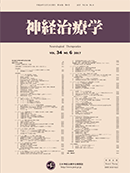Volume 34, Issue 3
Displaying 1-50 of 65 articles from this issue
-
2017Volume 34Issue 3 Pages 135-138
Published: 2017
Released on J-STAGE: October 14, 2017
Download PDF (341K)
-
2017Volume 34Issue 3 Pages 139-141
Published: 2017
Released on J-STAGE: October 14, 2017
Download PDF (325K)
-
2017Volume 34Issue 3 Pages 142-144
Published: 2017
Released on J-STAGE: October 14, 2017
Download PDF (337K)
-
2017Volume 34Issue 3 Pages 145
Published: 2017
Released on J-STAGE: October 14, 2017
Download PDF (181K) -
2017Volume 34Issue 3 Pages 146-150
Published: 2017
Released on J-STAGE: October 14, 2017
Download PDF (939K)
-
2017Volume 34Issue 3 Pages 151-154
Published: 2017
Released on J-STAGE: October 14, 2017
Download PDF (641K) -
2017Volume 34Issue 3 Pages 155-158
Published: 2017
Released on J-STAGE: October 14, 2017
Download PDF (384K) -
2017Volume 34Issue 3 Pages 159
Published: 2017
Released on J-STAGE: October 14, 2017
Download PDF (189K) -
2017Volume 34Issue 3 Pages 160-162
Published: 2017
Released on J-STAGE: October 14, 2017
Download PDF (338K) -
2017Volume 34Issue 3 Pages 163-166
Published: 2017
Released on J-STAGE: October 14, 2017
Download PDF (446K)
-
Therapeutic management of adult patients with bacterial meningitis based on Japanese guidelines 20142017Volume 34Issue 3 Pages 167-171
Published: 2017
Released on J-STAGE: October 14, 2017
Download PDF (1390K) -
2017Volume 34Issue 3 Pages 172
Published: 2017
Released on J-STAGE: October 14, 2017
Download PDF (236K) -
2017Volume 34Issue 3 Pages 173-177
Published: 2017
Released on J-STAGE: October 14, 2017
Download PDF (701K) -
2017Volume 34Issue 3 Pages 178-181
Published: 2017
Released on J-STAGE: October 14, 2017
Download PDF (380K) -
2017Volume 34Issue 3 Pages 182-187
Published: 2017
Released on J-STAGE: October 14, 2017
Download PDF (2761K) -
2017Volume 34Issue 3 Pages 188-192
Published: 2017
Released on J-STAGE: October 14, 2017
Download PDF (739K) -
2017Volume 34Issue 3 Pages 193
Published: 2017
Released on J-STAGE: October 14, 2017
Download PDF (241K) -
2017Volume 34Issue 3 Pages 194
Published: 2017
Released on J-STAGE: October 14, 2017
Download PDF (202K)
-
2017Volume 34Issue 3 Pages 195-198
Published: 2017
Released on J-STAGE: October 14, 2017
Download PDF (465K) -
2017Volume 34Issue 3 Pages 199-203
Published: 2017
Released on J-STAGE: October 14, 2017
Download PDF (489K) -
2017Volume 34Issue 3 Pages 204
Published: 2017
Released on J-STAGE: October 14, 2017
Download PDF (238K) -
2017Volume 34Issue 3 Pages 205-208
Published: 2017
Released on J-STAGE: October 14, 2017
Download PDF (417K) -
2017Volume 34Issue 3 Pages 209
Published: 2017
Released on J-STAGE: October 14, 2017
Download PDF (247K) -
2017Volume 34Issue 3 Pages 210
Published: 2017
Released on J-STAGE: October 14, 2017
Download PDF (246K) -
2017Volume 34Issue 3 Pages 211-214
Published: 2017
Released on J-STAGE: October 14, 2017
Download PDF (662K) -
2017Volume 34Issue 3 Pages 215-218
Published: 2017
Released on J-STAGE: October 14, 2017
Download PDF (1805K) -
2017Volume 34Issue 3 Pages 219
Published: 2017
Released on J-STAGE: October 14, 2017
Download PDF (186K)
-
2017Volume 34Issue 3 Pages 220-222
Published: 2017
Released on J-STAGE: October 14, 2017
Download PDF (682K) -
2017Volume 34Issue 3 Pages 223
Published: 2017
Released on J-STAGE: October 14, 2017
Download PDF (191K) -
2017Volume 34Issue 3 Pages 224-228
Published: 2017
Released on J-STAGE: October 14, 2017
Download PDF (1702K) -
2017Volume 34Issue 3 Pages 229-234
Published: 2017
Released on J-STAGE: October 14, 2017
Download PDF (1713K)
-
2017Volume 34Issue 3 Pages 235
Published: 2017
Released on J-STAGE: October 14, 2017
Download PDF (280K) -
2017Volume 34Issue 3 Pages 236-238
Published: 2017
Released on J-STAGE: October 14, 2017
Download PDF (1345K) -
2017Volume 34Issue 3 Pages 239
Published: 2017
Released on J-STAGE: October 14, 2017
Download PDF (153K) -
2017Volume 34Issue 3 Pages 240
Published: 2017
Released on J-STAGE: October 14, 2017
Download PDF (212K) -
2017Volume 34Issue 3 Pages 241-245
Published: 2017
Released on J-STAGE: October 14, 2017
Download PDF (577K)
-
2017Volume 34Issue 3 Pages 246
Published: 2017
Released on J-STAGE: October 14, 2017
Download PDF (232K) -
2017Volume 34Issue 3 Pages 247-251
Published: 2017
Released on J-STAGE: October 14, 2017
Download PDF (865K) -
2017Volume 34Issue 3 Pages 252
Published: 2017
Released on J-STAGE: October 14, 2017
Download PDF (243K) -
2017Volume 34Issue 3 Pages 253-256
Published: 2017
Released on J-STAGE: October 14, 2017
Download PDF (421K)
-
2017Volume 34Issue 3 Pages 257
Published: 2017
Released on J-STAGE: October 14, 2017
Download PDF (254K) -
2017Volume 34Issue 3 Pages 258-261
Published: 2017
Released on J-STAGE: October 14, 2017
Download PDF (482K) -
2017Volume 34Issue 3 Pages 262-265
Published: 2017
Released on J-STAGE: October 14, 2017
Download PDF (1144K) -
2017Volume 34Issue 3 Pages 266
Published: 2017
Released on J-STAGE: October 14, 2017
Download PDF (149K)
-
2017Volume 34Issue 3 Pages 267
Published: 2017
Released on J-STAGE: October 14, 2017
Download PDF (251K) -
2017Volume 34Issue 3 Pages 268
Published: 2017
Released on J-STAGE: October 14, 2017
Download PDF (245K) -
2017Volume 34Issue 3 Pages 269-272
Published: 2017
Released on J-STAGE: October 14, 2017
Download PDF (1050K) -
2017Volume 34Issue 3 Pages 273-274
Published: 2017
Released on J-STAGE: October 14, 2017
Download PDF (1234K)
-
2017Volume 34Issue 3 Pages 275-276
Published: 2017
Released on J-STAGE: October 14, 2017
Download PDF (314K) -
2017Volume 34Issue 3 Pages 277
Published: 2017
Released on J-STAGE: October 14, 2017
Download PDF (232K)
